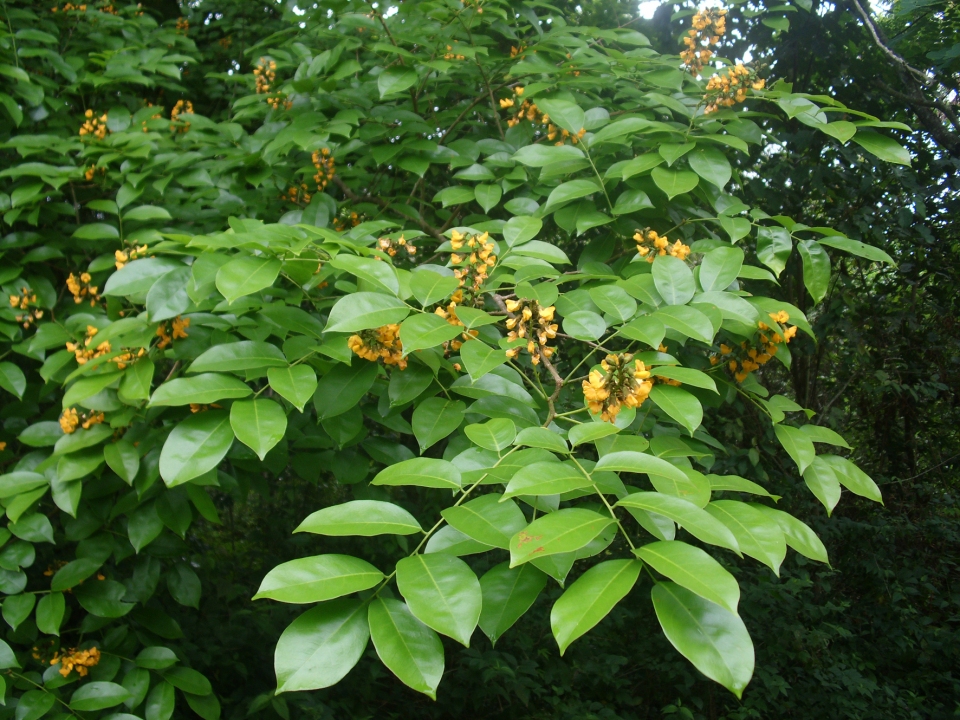Pterocarpus santalinioides

|
|
Pterocarpus santalinoides Common Names: Winged fruit, Red sandalwood, African
rosewood Scientific
Classification Kingdom: Plantae Clade: Tracheophytes Clade: Angiosperms Clade: Eudicots Clade: Rosids Order: Fabales Family: Fabaceae Genus: Pterocarpus Species: P. santalinoides Binomial Name: Pterocarpus
santalinoides L’Hér. ex DC. Synonyms: Lingoum esculentum (Schum. & Thonn.) Kuntze, Pterocarpus amazonicus Huber, Pterocarpus esculentus Schum. & Thonn., Pterocarpus grandis Cowan Morphological Description Pterocarpus santalinoides is a fast-growing, evergreen tree typically reaching heights
of 9–15 m, with exceptional specimens up to 20 m, and a trunk diameter of 0.5–1
m. It is characterized by: · Stem: Flaky, reddish-brown bark that peels in strips, exuding a
gum-like resin when cut, with a bole often straight and cylindrical · Leaves: Pinnate, 10–20 cm long, with 5–9 leaflets (each 3–7 cm long,
2–4 cm wide), glossy dark green, alternate · Flowers: Bright orange-yellow, 1–2 cm long, arranged in dense,
axillary or terminal panicles (5–15 cm long), blooming in the rainy season · Fruit: Flat, winged pods (3.5–6 cm long, 2–3 cm wide), with a wing
extending around three-quarters of the margin, containing 1–3 seeds The tree’s vibrant
flowers and winged pods contribute to its ecological and aesthetic value (Keay,
1989). Distribution and Habitat Pterocarpus santalinoides has a bi-continental distribution, native to tropical West
Africa (e.g., Nigeria, Ghana, Sierra Leone, Senegal, Côte d’Ivoire, Mali) and
parts of South America (e.g., Brazil, Colombia, Venezuela). It thrives in: · Riparian Forests: Along riverbanks and floodplains with high
moisture · Moist Lowland Forests: Tropical climates with rainfall of
1,000–2,500 mm annually · Savanna Edges: Transitional zones with well-drained soils It prefers fertile,
loamy soils (pH 5.5–7.0), temperatures of 25–35°C, and elevations from sea
level to 500 m, often growing in association with nitrogen-fixing bacteria
(Orwa et al., 2009). Ethnopharmacology Pterocarpus santalinoides, commonly known as African rosewood, is a
plant widely utilized in traditional medicine across West Africa. Various parts
of the plant, including the bark, roots, and leaves, are employed to treat
ailments such as bronchial complaints, amoebic dysentery, stomach aches, and
sleeping sickness; they are also used to prevent miscarriage and ease
childbirth. Scientific studies have demonstrated the plant's antimicrobial,
anti-inflammatory, and antioxidant properties, supporting its traditional use
in managing infections and inflammatory conditions. Additionally, the stem bark
extract has shown antihypertensive effects in animal models, suggesting
potential benefits in blood pressure regulation. Furthermore, the cooked young
leaves are consumed as a vegetable and added to soups, providing nutritional
benefits. · Antidiabetic: In Nigeria, leaf decoctions treat diabetes. Ethanol extracts
reduces fasting blood glucose by 64.5% in alloxan-induced diabetic rats at 5
mg/kg, linked to isovitexin (Ihedioha et al., 2020). · Antimicrobial: In Ghana, bark infusions combat infections. tudy assessed
the antimicrobial efficacy of hydroalcoholic extracts from the leaves, stem
bark, and roots of P. santalinoides against several bacterial strains,
including both wild-type and reference strains of Escherichia coli,
Staphylococcus aureus, Salmonella species, and Pseudomonas aeruginosa. The
results indicated that the stem bark extract exhibited the most potent
activity, with minimum inhibitory concentrations (MICs) ranging from 3.125 to
25 mg/mL. Leaf extracts demonstrated MICs between 6.25 and 25 mg/mL, while root
extracts had MICs ranging from 12.5 to 50 mg/mL. (Ayéna et al., 2020). · Anti-inflammatory: In Côte d’Ivoire, root pastes ease
bronchial complaints. Stem bark extracts reduce paw edema by 39.5% in rats at
500 mg/kg, attributed to phenolic compounds (Ayéna et al., 2022). · Wound Healing: In Benin, leaf poultices promote wound closure. Ethanol
extracts enhance healing in excision models, supporting traditional use (Biswas
et al., 2004). · Antitrypanosomal: In Nigeria, leaves treat sleeping
sickness. Hydroethanol extracts reduce Trypanosoma brucei parasitemia in rats at 400 mg/kg, linked
to flavonoids (Obi et al., 2020). ⚠ Toxicity Profile: Roasted seeds are edible, but raw seeds contain
tannins (5–10% dry weight) and cyanogenic glycosides (0.1–0.2 mg/g),
potentially releasing cyanide (LD₅₀ > 5,000 mg/kg in rats). Excessive bark
consumption may cause gastrointestinal irritation due to high tannin content
(15–20%). Caution is advised (Ayéna et al., 2022). Phytochemistry The plant’s bioactivity
is attributed to its diverse phytochemicals: · Flavonoids: Isovitexin (0.1–0.3%), quercetin, with antidiabetic and
antimicrobial effects · Tannins: Catechin, gallic acid (5–15%), contributing to astringent
properties · Terpenoids: β-sitosterol, lupeol, enhancing anti-inflammatory activity · Alkaloids: Trace amounts, supporting antitrypanosomal effects These compounds,
identified via HPLC and NMR, underpin its medicinal versatility (Ihedioha et
al., 2020). Additional Uses · Agroforestry: Nitrogen fixation (50–100 kg/ha annually) improves soil
fertility (Bright et al., 2017) · Culinary: Roasted seeds and tender leaves used in soups in Nigeria · Economic: Hardwood for construction; gum as a dye or adhesive · Cultural: Bark used in Mali rituals for childbirth blessings References
External Links More Pictures |
|
| Compounds of Pterocarpus santalinioides | |
| References |